A modest Derbyshire tart, this, but one whose very name excites controversy. In Bakewell itself, it's definitely a pudding, the name by which it was apparently known until the 20th century, though, as Alan Davidson's Oxford Companion to Food observes, truth be told it's "more of a tart", wherever it's baked.
The more interesting discussion, as far as I'm concerned, concerns the filling. Although, according to this incredibly comprehensive article on its origins, the first recorded recipe dates from 1836, its medieval precursors came in two main forms: flavoured custard tarts with candied fruit, and Lenten almond-paste tarts.
Strangely, recipes up to the mid-20th century tend towards the custard sort, but these days, if it doesn't contain frangipane, it's not a bakewell tart. (Or pudding.) But that frangipane shouldn't be stodgy, or wincingly sweet. The pastry mustn't be cardboardy, or soft. And the jam … well, that's a veritable wasp's nest.
Pastry
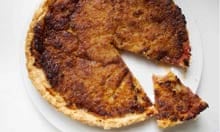
Let's start with the relatively straightforward matter of pastry. Puff seems to be more traditional, quoted in both the 1836 recipe and an 1837 one held by the Derbyshire Record Office, but the only modern version I find using it is Ruth Lowinsky's 1931 version, included in Arabella Boxer's Book of English Food. Boxer says she makes hers with short instead, but I stick with the original, and decide she's right; this would work well with a soft, wobbly custard filling, but it's too flimsy for frangipane.
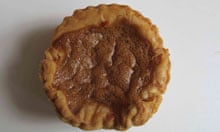
Florence White's "early 19th-century recipe still used in Derbyshire", taken from her Good Things in England, simply specifies "rich pastry", which I take to mean a shortcrust enriched with egg, as used by Annie Bell in her Baking Bible. I don't think this, or the ground almonds Bell also adds, are necessary though: I much prefer the savoury plainness of Tamasin Day-Lewis's ordinary shortcrust, which sets off the rich frangipane nicely. I'm opting for a high butter to flour ratio, to ensure optimum crispness.
Bell, and London baker Lily Vanilli (whose tarts, according to Vogue, are the "best in town") blind-bake the pastry shell, rather than adding the filling straight to the raw pastry, which also adds crunch. She and White's source both make tartlets rather than full-sized tarts, which give a rather high pastry to frangipane ratio. Vanilli's do look very pretty indeed though: worth bearing in mind for a picnic, should the weather hold.
Fruit
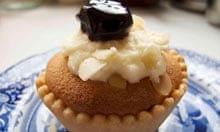
Jam is, of course the order of the day here: Bell and Day-Lewis use raspberry, which I'd consider traditional, but as it seems the earliest recipes all involve candied fruit, everything's to play for here. Indeed, White chooses strawberry, and Lowinsky a greedy two layers, one of apricot, and one of strawberry. Raspberry remains my favourite, but I'm swayed by Vanilli's alternative – in her book, Sweet Tooth, she writes that in the bakery, they vary the fruit by season, and, as not much is in the shops yet, I plump for a frozen berry compote. It provides a beautifully sharp foil for the sweet, fluffy frangipane above. Not traditional, perhaps, but then, neither is jam. If you're attached to the latter however, go for a low-sugar version for a fruitier finish.
Frangipane … or not
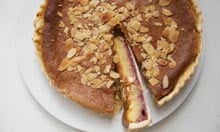
Bell and Vanilli both make their frangipanes in much the same way as one might make a sponge cake, creaming together butter and sugar, beating in eggs, then folding in dry ingredients (ground almonds for Bell, almonds and flour for Vanilli). Both are pleasingly light and fluffy; more so than the denser, moister frangipane in Day-Lewis's recipe, made by whisking hot melted butter into the remaining ingredients, which makes it more of a sophisticated, "just a sliver" dessert option. I prefer the slightly more savoury flavour of Vanilli's frangipane, which I attribute to the flour, but, like Bell, I'll be adding a little baking powder to the mixture too, for extra lift.
Day-Lewis flavours her frangipane with bitter almond extract, which stops it from being too sweet, and Vanilli does the same with citrus zest. Grapefruit tastes weird here, and orange is too strident, so I'll be going with lemon, to match the juice in my compote.
Lowinsky doesn't use a frangipane at all: instead she adds a layer of ground almonds on top of the jam, and then tops it with a mixture made from butter, sugar, eggs and breadcrumbs, with a hefty dose of lemon juice. It's more like a jam-flavoured treacle tart than anything else.White leaves the almonds out altogether in favour of a custard, made by pouring hot butter into eggs and sugar. As a custard tart, it's nice enough. As a bakewell, I think its moment has passed.
Extras
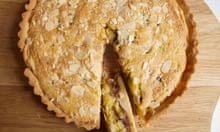
As if there weren't enough almonds involved here, Bell lines her tart with a layer of marzipan – overkill. I'm also unconvinced by the raisins she adds to the frangipane, which contribute yet more sweetness. Sadly (given I never miss an opportunity to eat the stuff from a spoon), I must say that same for Vanilli's almond buttercream: it looks pretty, but it's just gilding the lily here. The cherries on top do work nicely though, if you're going for mini tartlets. Personally, I prefer a more traditional flaked almond finish, as used by Vanilli, Bell and Day-Lewis, which provides a pleasing final crunch to every mouthful of your tart – or pudding. Call it whatever you want, it'll still be delicious.
The perfect bakewell tart
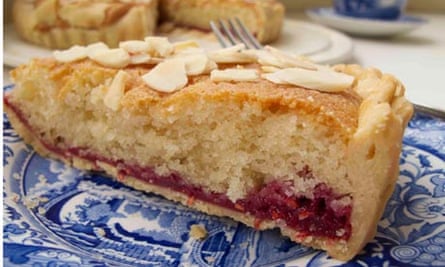
Makes a 23cm bakewell tart
For the pastry:
140g plain flour, plus extra to sprinkle
85g cold butter, plus extra to grease
Pinch of salt
Ice cold water
For the frangipane:
110g butter
110g caster sugar
2 eggs
110g ground almonds
25g plain flour
½tsp baking powder
Zest of ½ lemon
For the compote (or use 100g low-sugar raspberry jam):
250g raspberries (fresh or frozen)
25-35g caster sugar depending on sweetness of tooth
Juice of ½ lemon
25g flaked almonds, to top
To make the pastry, mix the flour and salt in a bowl, and then grate in the cold butter. Rub this into the flour, then stir in just as much cold water as you need to bring it together into a dough; it should not be sticky. Alternatively use a food processor. Wrap in clingfilm and chill for at least an hour. Preheat the oven to 190C (170C fan)/gas mark 5.
Grease a 23cm tart tin and roll out the pastry on a lightly floured surface until large enough to line the tin. Do so, then line with baking paper and weigh down with baking beans or dried pulses. Bake for about 15 minutes until golden.
Meanwhile, make the compote, if using, by putting the berries into a small pan with the sugar and lemon juice and bringing to the boil. Simmer for about 12 minutes until thickened. Allow to cool slightly.
To make the frangipane, cream together the butter and sugar until fluffy, then beat in the eggs. Fold in the dry ingredients and zest and a pinch of salt.
Remove the paper and beans and return the pastry to the oven for a couple of minutes until golden. Spread the compote over the base, and top with the frangipane. Level out and bake for 25 minutes until golden and well risen. Add the almonds on top in the last 5 minutes of cooking.
When it comes to bakewells, are you a pudding person or a tart fancier? Do you ring the changes with fruit, or stick with red jam? And does anyone still cling to the custard version?
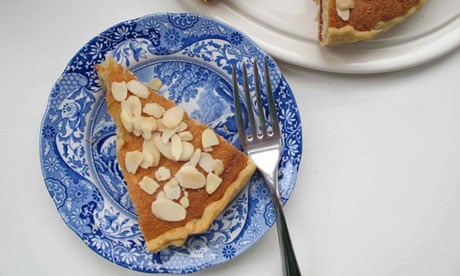
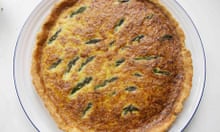

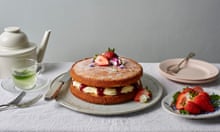


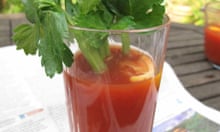
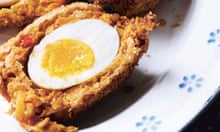
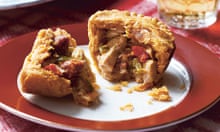

Comments (…)
Sign in or create your Guardian account to join the discussion